The Google Nexus 9 Review
by Joshua Ho & Ryan Smith on February 4, 2015 8:00 AM EST- Posted in
- Tablets
- HTC
- Project Denver
- Android
- Mobile
- NVIDIA
- Nexus 9
- Lollipop
- Android 5.0
GPU Performance
While Denver is new, the Kepler GPU in the Tegra K1 is mostly a known quantity by now. In the Nexus 9, the GPU is still a single SMX clocked to 852 MHz. In order to verify performance, we turn to our standard test suite. For the most part, our GPU-bound tests are meant to represent gaming performance although tests like 3DMark can have CPU-bound aspects while GFXBench tends towards being a pure GPU test.
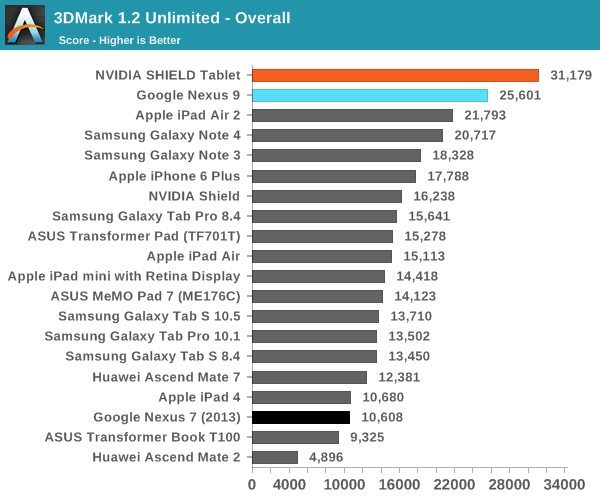
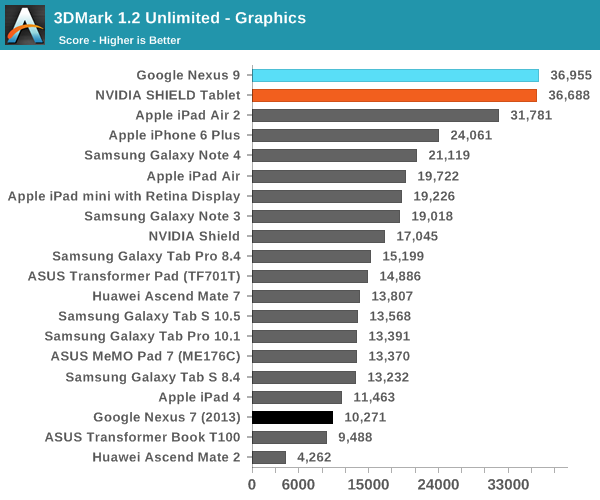
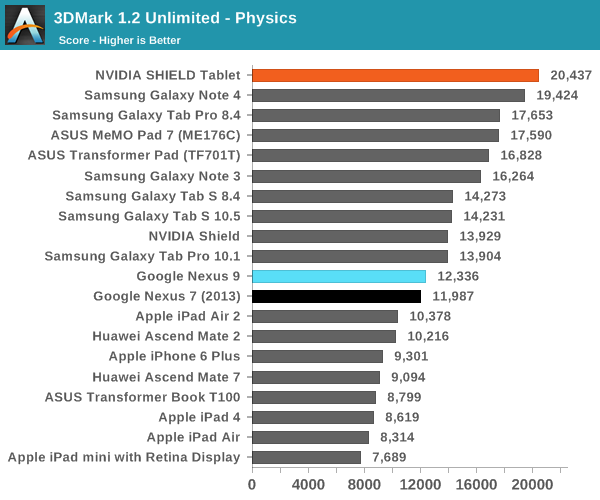
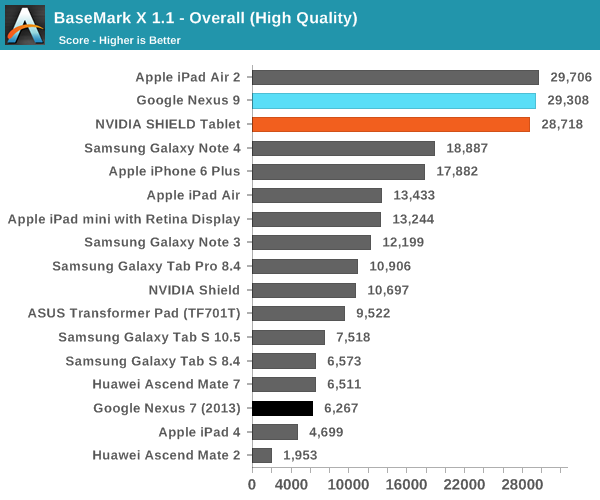
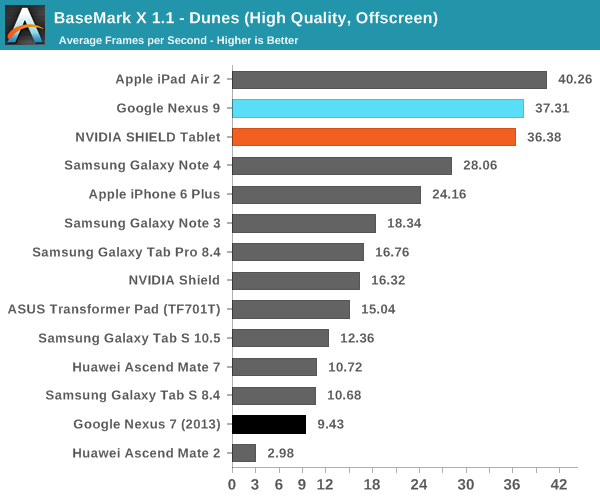
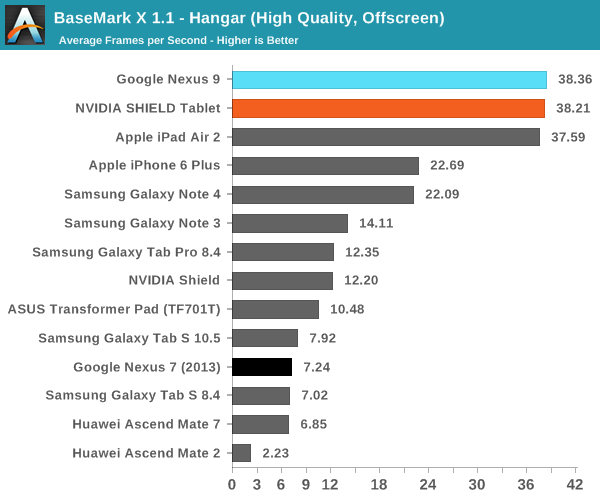
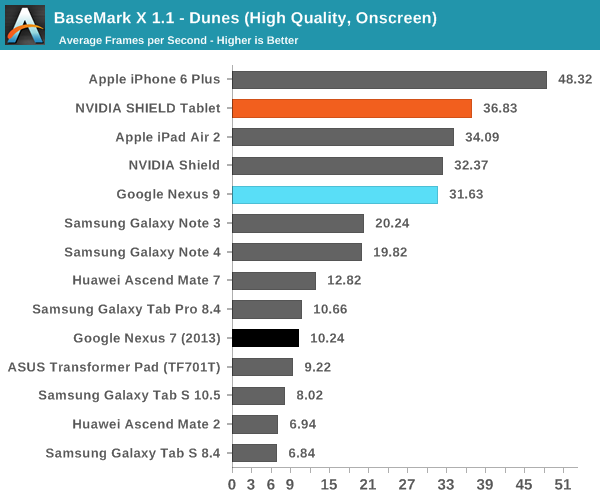
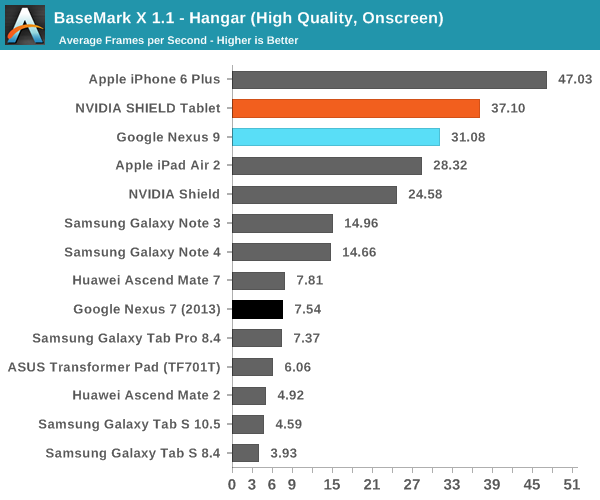
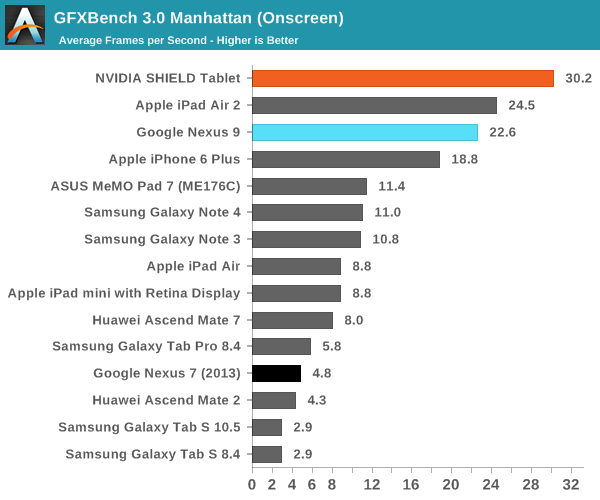
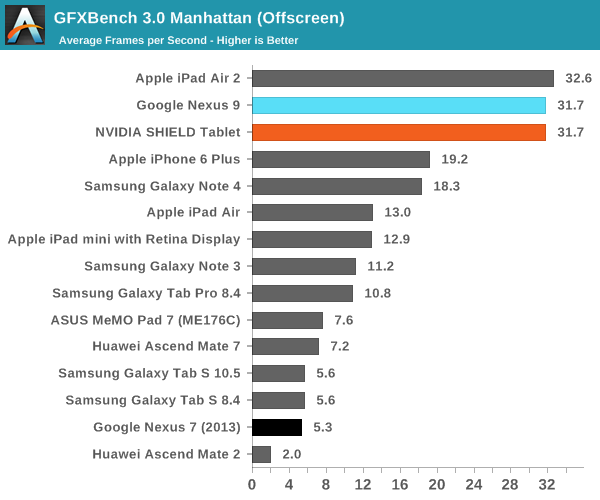
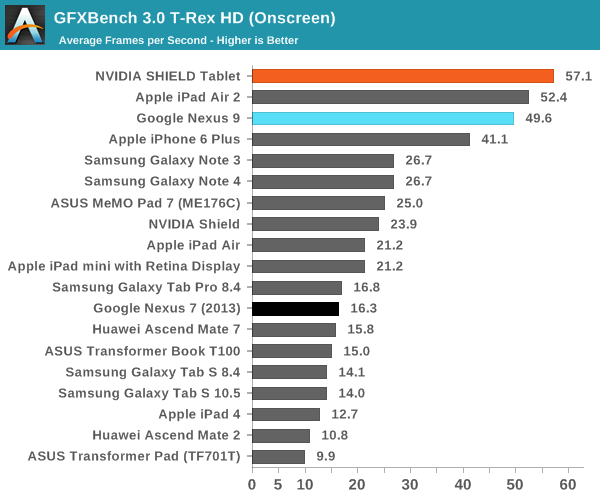
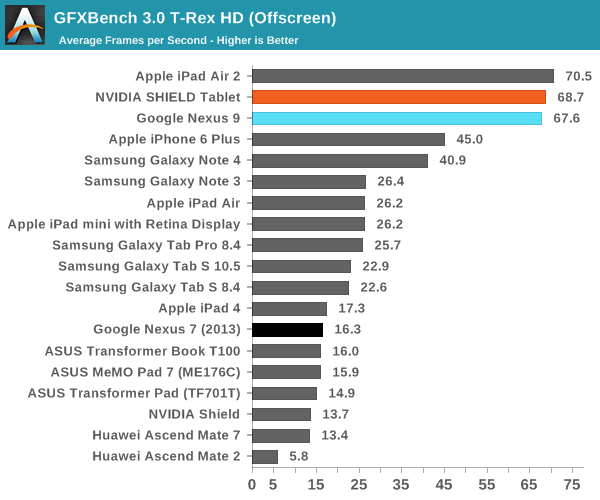
The Nexus 9's GPU has effectively identical performance to what we saw in the SHIELD Tablet, which means that the Nexus 9 should be able to support a broad range of games without performance issues. There is a bit of a noticeable performance delta when comparing on-screen performance, but this is simply due to the higher resolution of the Nexus 9's display. The one notable exception is the 3DMark physics test, which seems to scale with core count quite well, and that causes Denver to fall slightly short of the quad A15 configuration.
NAND Performance
While storage performance can often be secondary to a smooth user experience, poor storage performance is extremely painful. This is similar to RAM, where the difference between 2 and 3 GB is generally academic, while the difference between 512MB and 1 GB is enormous. While there have been some issues with Androbench with the move to Android 5.0, it seems that the timer issues have since been resolved, so it's possible to resume using the results from Androbench to get a rough idea of NAND performance.
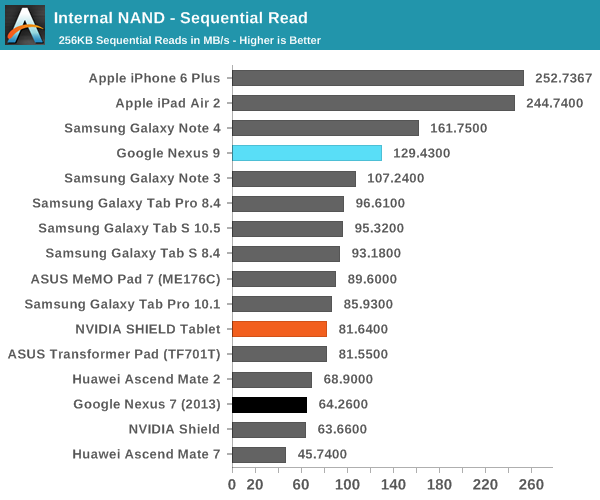
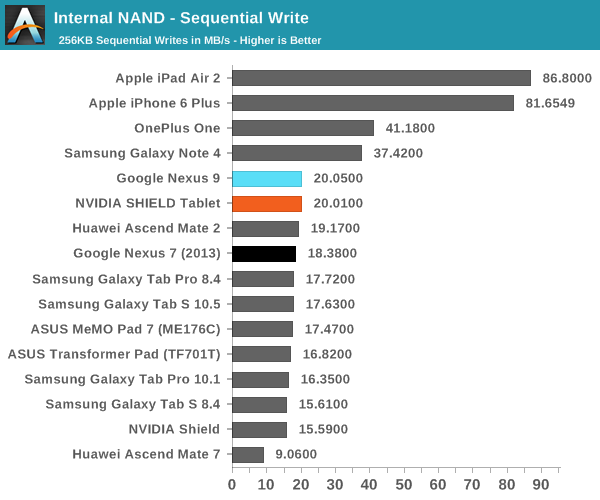
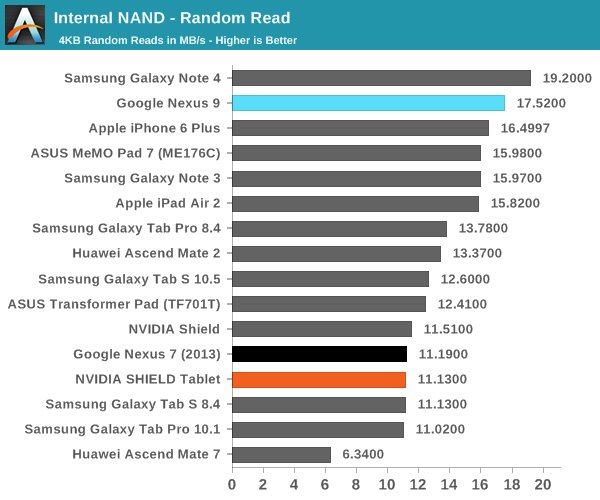
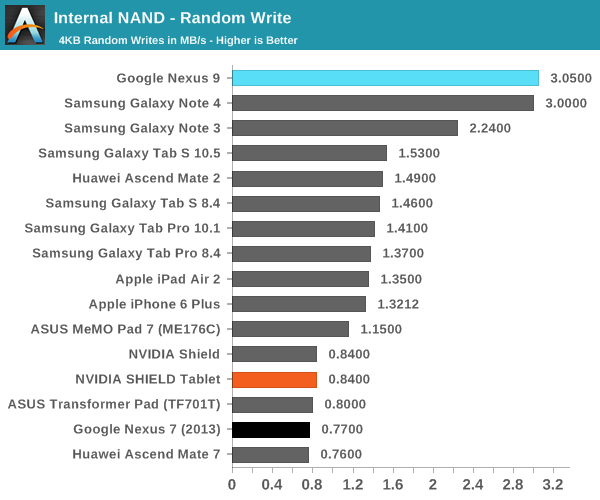
Here the Nexus 9 doesn't suffer nearly as much from full disk encryption that is forcibly enabled on the device; performance is noticeably higher than what we see in the Nexus 6. This seems to lend some credence to the theory that CPUs with ARM v8 ISA would be better suited to handling the need to encrypt and decrypt storage in real time. I tested the Nexus 9 with a custom kernel without full disk encryption to see how Androbench scores might change, but this didn't have a noticeable impact which seems to back this theory, although I'm still not confident that FDE is a good idea to enforce across all new devices.
The NAND itself, a Samsung eMMC package designated by the name BWBC3R, seems to be quite performant outside of pure sequential access, which seems to suggest that HTC hasn't skimped out in this area at all, and the use of F2FS is responsible for some of the best random I/O scores in any mobile devices we've tested thus far.










169 Comments
View All Comments
rpmrush - Wednesday, February 4, 2015 - link
I find the 4:3 aspect ratio a turn off. Why change now. There are zero apps natively designed for this in the Android ecosystem. Why would a developer make a change for one device? It just seems like more fragmentation for no reason. I'm picking up a Shield Tab soon.kenansadhu - Wednesday, February 4, 2015 - link
One example to drive my point: I bought kingdom rush and found out that on my widescreen tablet, the game won't fit the screen properly. If any, this will fit apps previously designed for ipads well. Hate to admit it, but apple has such a huge lead in the tablet market it's just reasonable for developers to focus on them first.melgross - Wednesday, February 4, 2015 - link
Well, there are almost no tablet apps at all for Android. One reason is because of the aspect ratio being the same for phones and tablets. Why bother writing g a tablet app when the phone app can stretch to fit the screen exactly? Yes, they're a waste of time, but hey, it doesn't cost developers anything either.Maybe goi g to the much more useful 4:3 ratio for tablets will force new, real tablet apps.
It's one reason why there are so many real iPad apps out there.
retrospooty - Wednesday, February 4, 2015 - link
You sound like you are stuck in 2012. Update your arguments ...UtilityMax - Sunday, February 8, 2015 - link
There will be more tablets coming with 4:3 screen. Samsung's next flagship tablet will be 4:3. As much as I like watching movies on a wide screen, I think it's not the killer tablet application for most users, and most people will benefit from having a more balanced 4:3 screen. It works better for web browsing, ebooks, and productivity apps.Impulses - Wednesday, February 4, 2015 - link
Most simpler apps just scale fine one way or the other... I think 4:3 makes a ton of sense for larger tablets, it remains almost exactly as tall in landscape mode (which a lot of people seem to favor, and I find bizarre) and more manageable in portrait since it's shorter.7-8" & 16:9 is still my personal preference, since I mostly use it for reading in portrait. Try to think outside of your personal bubble tho... I bought the Nexus 9 for my mother who prefers a larger tablet, never watches movies on it, yet almost always uses it in landscape.
It'll be perfect for her, shoot, it even matches the aspect ratio of her mirrorless camera so photos can be viewed full screen, bonus.
UtilityMax - Sunday, February 8, 2015 - link
I personally think about the reverse. Big tablets with 9-11 screens are often bought for media consumption. Because of that, it makes sense for them to come with a wide screen. For me, having wide screen for watching movies on the flights and in the gym was one of the prime reasons to buy a Samsung Galaxy Tab S 10.5, even though its benchmarks look only so so.However, a 9 to 11 inch tablet is too bulky to hold in one hand and type with another. It almost begs for a stand. So for casual use, like casual web browsing or ebook reading, a smaller tablet with a 4:3 screen works better. And so I went ahead and got a tablet with 4:3 screen for that purpose.
Impulses - Monday, February 9, 2015 - link
Valid points, obviously usage cases can differ a lot, that's the nice thing about Android tho... It doesn't have to conform to any one aspect ratio that won't fit everyone's taste.LordConrad - Wednesday, February 4, 2015 - link
I love the 4:3 aspect ratio. I primarily use tablets in Portrait Mode, and have always disliked the "tall and thin" Portrait Mode of traditional android tablets. This is the main area where Google has always fallen behind Apple, IMHO. This is the main reason I gave my Nexus 7 (2013) to my nephew and bought a Nexus 9, and I have no regrets.R. Hunt - Thursday, February 5, 2015 - link
Agreed. I understand that YMMV and all that, but to me, large widescreen tablets are simply unusable in portrait. I'd love to have the choice of a 3:2 Android tablet though.